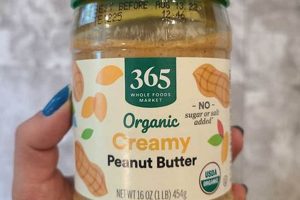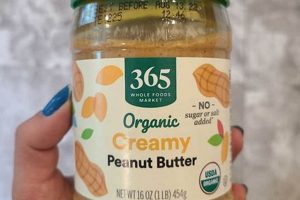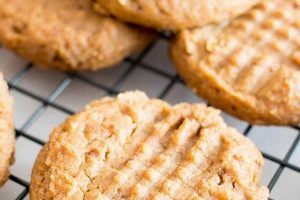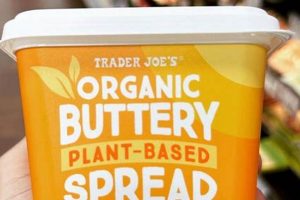A plant-based alternative replicating the functionality of dairy-based butter is crucial for various culinary applications, particularly in the realm of baked goods. This category of ingredients aims to mimic the texture, flavor, and performance of traditional butter, allowing individuals following a plant-based diet, or those with dairy sensitivities, to enjoy a wider range of baked treats. Examples include products formulated from coconut oil, shea butter, sunflower oil, and combinations of plant-based fats designed to emulate butter’s melting point and emulsification properties.
The development and utilization of these alternatives holds considerable significance. They enable inclusivity in baking, extending the enjoyment of traditionally dairy-rich recipes to a broader audience. Furthermore, the environmental impact of plant-based fats is often lower compared to dairy production, offering a more sustainable option. Historically, the need for butter substitutes stemmed from periods of scarcity or cost constraints; however, the modern focus is driven by ethical, health, and environmental considerations. The increasing availability and sophistication of these products demonstrate a growing awareness and demand for sustainable and inclusive food options.
The following sections will explore the diverse range of plant-derived fats available, examining their individual characteristics and suitability for different types of baked goods. Further analysis will detail how to effectively incorporate these alternatives into recipes, providing guidance on achieving optimal results in terms of texture, flavor, and overall baking performance. This includes discussing techniques for adjusting recipes to accommodate the unique properties of each ingredient.
Baking Successfully with Plant-Based Butter Alternatives
Achieving desirable results when substituting conventional dairy butter with plant-based options requires careful consideration. The following guidelines offer practical advice for optimal baking outcomes.
Tip 1: Fat Composition Matters: Plant-based butters exhibit varying fat profiles. Alternatives primarily composed of coconut oil may produce different textures than those based on olive or sunflower oil. Examine the ingredient list and select options with a similar fat content to dairy butter for closer results.
Tip 2: Temperature Considerations are Essential: Plant-based butters often melt at slightly different temperatures than dairy butter. Observe the melting behavior and adjust recipe instructions accordingly. If a recipe requires softened butter, ensure the plant-based alternative reaches a similar consistency without becoming excessively liquid.
Tip 3: Account for Added Water: Some plant-based butter alternatives contain a higher water percentage than dairy butter. This can impact the gluten development in doughs and batters. Adjust liquid measurements in the recipe as needed, reducing water or other liquids slightly to compensate.
Tip 4: Consider Salt Content: The salt content in different plant-based butters can vary significantly. Taste the alternative before incorporating it into a recipe and adjust the overall salt content accordingly. This ensures the final product achieves a balanced flavor profile.
Tip 5: Emulsification may need Assistance: Plant-based butters may not emulsify as readily as dairy butter, potentially impacting the texture of cakes and frostings. Incorporate an emulsifier, such as soy lecithin, or consider creaming the plant-based butter with sugar for a longer duration to promote proper emulsification.
Tip 6: Adjust Baking Time: Baked goods prepared with plant-based butter alternatives may require slightly adjusted baking times. Monitor the color and internal temperature of the product closely to prevent under- or over-baking. Insert a toothpick or cake tester into the center to check for doneness.
Tip 7: Recipe Selection: Certain recipes respond better to plant-based butter substitutions than others. Recipes that rely heavily on butter’s flavor, such as shortbread, may require alternatives with a more pronounced buttery flavor, achieved through natural flavorings or careful brand selection. Cakes, cookies, and muffins are generally more forgiving.
These techniques offer essential adjustments, enabling the effective integration of plant-based butter alternatives within baking. These adjustments ensure successful texture and flavor profiles for various baked goods.
The subsequent discussion turns to the specific recipes for vegan baking. The adjustment with using vegan butter alternatives will be discussed.
1. Fat Composition
The fat composition of a vegan butter alternative directly influences its performance in baked goods. Dairy butter derives its structure and functionality from a complex mixture of saturated and unsaturated fats. Vegan replacements aim to replicate this blend, but the source and proportion of fats will significantly alter the final product’s texture, flavor, and overall structure. For instance, a vegan butter heavily reliant on saturated fats like coconut oil will produce a firmer baked good with a tendency to be dry, while a blend with a higher proportion of unsaturated fats, such as olive oil or sunflower oil, may result in a softer, potentially greasier outcome. The type of fat directly dictates the melting behavior and emulsification properties, fundamentally impacting the rise, crumb structure, and mouthfeel of the baked product. The selection of appropriate fat blends represents a central challenge in creating effective vegan butter alternatives.
Consider the example of cookies: a cookie recipe relying on the creaming of butter and sugar for aeration and structure requires a vegan butter with a similar ratio of solid to liquid fats at room temperature. If the chosen alternative is predominantly coconut oil, the cookies may spread less and be denser. Conversely, a cookie made with a vegan butter high in unsaturated fats may spread excessively, resulting in a thin, crisp cookie. Similarly, in cake baking, the fat composition influences the tenderness and moistness of the crumb. A vegan butter that does not emulsify well can lead to a coarser texture. Formulations that incorporate shea butter or cocoa butter can contribute to a more stable emulsion and a smoother mouthfeel, approximating the characteristics of dairy butter.
In summary, understanding the intricate relationship between fat composition and the characteristics of vegan butter alternatives is paramount for successful baking. The choice of fats directly determines the texture, flavor, and overall performance of the baked product. Matching the fat profile of dairy butter as closely as possible, while considering the specific requirements of each recipe, is critical. Challenges remain in achieving a perfect replication, but ongoing research into fat blends and emulsification techniques continues to improve the viability and versatility of these alternatives. The composition of plant-based fats are indeed a very crucial for vegan butter replacements.
2. Melting Point
The melting point of fats is a critical factor in determining the functionality of butter in baking. In the context of alternatives, the melting point of the selected replacement influences the texture, structure, and overall success of the baked product.
- Impact on Creaming
The creaming process, where butter and sugar are combined to incorporate air, relies heavily on the fat being solid yet pliable. Vegan butter alternatives with significantly lower melting points may be too soft to effectively trap air, resulting in a dense, less airy product. Conversely, a very high melting point can make creaming difficult, leading to an uneven mixture. Thus, a melting point close to that of dairy butter is desirable for recipes requiring creaming.
- Influence on Spread
During baking, the melting point determines how much a dough or batter spreads. A low melting point results in excessive spreading, producing thin, flat cookies or cakes. A higher melting point may lead to less spread and a denser, more compact outcome. The ideal melting point will allow for controlled spread, contributing to the desired texture and appearance.
- Effect on Texture
The melting point directly impacts the final texture of baked goods. Fats that remain solid at room temperature will contribute to a firmer texture, while those that melt easily will result in a softer or more tender product. The choice of alternative should align with the desired textural outcome. For instance, a vegan butter with a lower melting point may be preferable for a soft, chewy cookie, while one with a higher melting point may be better suited for a crisp, shortbread-like texture.
- Role in Emulsification Stability
The temperature at which fats melt also affects the stability of emulsions in baked goods. The optimal melting point is crucial for stabilizing emulsions, preventing separation of ingredients, and producing a uniform texture. If the melting point is not well-matched to other ingredient interactions, this can cause instability. A stable emulsion ensures consistent distribution of moisture and fat, enhancing the overall quality of the final product.
Therefore, the melting point is a key consideration when using butter replacements in baking. Successful applications require careful selection of alternatives with melting points comparable to dairy butter and appropriate for the specific recipe and desired textural outcome. Matching or closely approximating this temperature enables the creation of plant-based baked goods that closely resemble their dairy-based counterparts in terms of appearance, texture, and overall eating experience.
3. Water Content
Water content within vegan butter alternatives directly influences the texture, structure, and baking performance of finished goods. Dairy butter typically contains a specific percentage of water, which contributes to steam generation during baking, aiding in leavening and creating a moist crumb. Variations in water content within vegan butter alternatives, relative to dairy butter, can cause noticeable differences in baked product outcomes. Increased water content, for instance, may lead to a denser product due to increased gluten development, while reduced water content could result in a drier, more crumbly texture. The selection of a plant-based butter replacement requires careful attention to its water content to ensure optimal recipe execution.
For example, consider the production of vegan pie crust. If a vegan butter alternative with significantly higher water content than dairy butter is used, the resulting crust may become tough and shrink during baking. The excess water encourages gluten formation, leading to a less tender crust. Conversely, if the vegan butter alternative has minimal water content, the crust may be overly crumbly and difficult to handle. Practical applications involve adjusting the liquid content of recipes to compensate for differences in the plant-based butter’s water content. Reducing the amount of added liquid or increasing the proportion of dry ingredients can help mitigate the effects of a high-water-content alternative. The opposite approach may be necessary for low-water-content alternatives. Careful attention is required during the mixing phase to ensure proper dough hydration and prevent over- or under-mixing, which can further impact the final texture.
In summary, water content stands as a critical factor when substituting dairy butter with vegan alternatives in baking. Variations in water content directly impact texture, structure, and overall baking performance. Practical understanding of water content necessitates recipe adjustments, particularly to liquid quantities, to achieve optimal results. Challenges remain in precisely matching the water content of dairy butter, but careful consideration and adjustments allow for the successful creation of plant-based baked goods that approximate the characteristics of their dairy-based counterparts. This underscores the importance of considering the vegan butter replacements when selecting one.
4. Emulsification
Emulsification plays a critical role in the success of vegan butter alternatives in baking. Dairy butter naturally contains emulsifiers that contribute to the stable combination of water and fat, resulting in desirable texture and structure in baked goods. Vegan butter replacements often lack these naturally occurring emulsifiers, potentially leading to separation, poor aeration, and compromised final product quality. Proper emulsification ensures even distribution of moisture and fat throughout the batter or dough, influencing tenderness, crumb structure, and overall mouthfeel. The absence of effective emulsification can result in a coarse, uneven texture, or a greasy mouthfeel due to unincorporated fats. For example, in cake baking, poor emulsification can lead to a dense, heavy cake with a greasy layer at the bottom. In cookie production, it can cause excessive spread or an uneven texture.
To compensate for the lack of natural emulsifiers in many vegan butter alternatives, manufacturers often incorporate additives such as soy lecithin, sunflower lecithin, or mono- and diglycerides. These added emulsifiers help to stabilize the mixture of plant-based fats and water, mimicking the emulsifying properties of dairy butter. However, the effectiveness of these additives can vary depending on the specific formulation and baking conditions. Bakers may also employ techniques to enhance emulsification, such as creaming the vegan butter replacement with sugar for an extended period to promote the incorporation of air and the formation of a stable emulsion. Another approach involves adding a small amount of an emulsifying agent directly to the recipe, although careful measurement is necessary to avoid altering the flavor or texture negatively. The choice of emulsification method depends on the specific recipe and the characteristics of the vegan butter alternative used.
In conclusion, emulsification is a crucial consideration when using vegan butter alternatives in baking. The absence of natural emulsifiers in many plant-based replacements can lead to undesirable textural and structural outcomes. The incorporation of emulsifying agents or the application of specific baking techniques can mitigate these issues, allowing for the successful creation of plant-based baked goods that closely resemble their dairy-based counterparts. Challenges persist in achieving perfect emulsification, but ongoing research into alternative emulsifiers and improved baking methods continues to advance the viability and versatility of vegan butter replacements. The effective of “vegan butter replacement for baking” is really related to emulsification process.
5. Flavor Profile
The flavor profile of vegan butter alternatives is a critical determinant of their suitability in baking applications. It dictates the extent to which these replacements can mimic the sensory characteristics of dairy butter, influencing the overall acceptance and palatability of the final baked product.
- Base Oil Influence
The primary oil source used in the production of vegan butter alternatives significantly impacts the resulting flavor profile. Coconut oil, for example, imparts a distinct sweetness and aroma that may be desirable in certain applications, such as shortbread or cookies, but can be overpowering in more neutral recipes. Olive oil-based alternatives may contribute a subtle savory note, potentially altering the flavor balance of delicate pastries. Manufacturers often employ blends of various plant-based oils to achieve a more neutral or butter-like flavor. These oil blends will dramatically impact the “vegan butter replacement for baking”.
- Added Flavorings
To enhance the buttery character of vegan butter alternatives, many manufacturers incorporate natural or artificial flavorings. These flavorings can range from subtle butter esters to more pronounced diacetyl notes, attempting to replicate the complex flavor compounds present in dairy butter. The effectiveness of these flavorings varies, and excessive use can result in an artificial or chemical taste. Careful consideration must be given to the type and concentration of flavorings used to achieve a balanced and authentic buttery flavor.
- Salt Content Modulation
Salt plays a crucial role in enhancing and balancing the flavor of both dairy and vegan butters. The addition of salt not only contributes to the overall taste but also helps to mask any undesirable off-flavors from the base oils or flavorings. The optimal salt content depends on the specific recipe and desired flavor profile. Some vegan butter alternatives are available in both salted and unsalted varieties, allowing bakers to control the salt content more precisely. Too much salt can impact the taste, and that will result to be unpalatable result.
- Impact on Recipe Compatibility
The flavor profile of a vegan butter alternative must be compatible with the other ingredients in the recipe. Alternatives with strong or distinctive flavors may clash with certain spices, fruits, or extracts, altering the intended flavor outcome. Neutral-tasting alternatives are generally more versatile and can be used in a wider range of recipes without significantly affecting the flavor profile. The best selection is always the natural flavor ones. A strong flavor alter the goal for the recipe to taste in a balance result.
The interplay of base oils, added flavorings, and salt content ultimately determines the flavor profile of vegan butter alternatives. Selecting an alternative with a flavor that complements the intended recipe is essential for achieving optimal sensory results. While replicating the precise flavor nuances of dairy butter remains a challenge, careful formulation and informed ingredient selection can produce vegan baked goods that are both delicious and satisfying. These choices are the key ingredient of choosing “vegan butter replacement for baking”.
Frequently Asked Questions
The following addresses common inquiries regarding the use of plant-based butter alternatives in baking, offering guidance on achieving optimal results.
Question 1: Are all vegan butter replacements suitable for all baking applications?
No. Different vegan butter replacements exhibit varying fat compositions, melting points, and water contents. These characteristics impact their performance in different recipes. Select an alternative whose properties align with the requirements of the specific baked good.
Question 2: How does the melting point of vegan butter replacements affect baking?
The melting point influences spread, texture, and creaming ability. Alternatives with lower melting points may cause excessive spreading, while those with higher melting points may result in denser textures. The ideal melting point will allow controlled spread and the desired texture for the recipe.
Question 3: What adjustments might be needed when using vegan butter replacements in recipes?
Adjustments may include modifying liquid quantities to compensate for differences in water content, adjusting baking times to account for variations in heat transfer, and incorporating emulsifiers to improve texture. Salt content may also need adjustment for desired flavor balance.
Question 4: Do vegan butter replacements always taste the same as dairy butter in baked goods?
No. Vegan butter replacements often have distinct flavor profiles influenced by the base oils and added flavorings used in their production. The flavor may be subtle or pronounced, requiring careful selection to complement the other ingredients in the recipe.
Question 5: Can vegan butter replacements be used in recipes that require creaming butter and sugar?
Yes, but the process may require adjustment. Ensure the vegan butter replacement is softened to a similar consistency as dairy butter and cream it with sugar for an extended period to promote proper aeration and emulsification.
Question 6: Are there specific recipes that are more challenging to adapt to vegan butter replacements?
Recipes that heavily rely on the flavor and structural properties of dairy butter, such as puff pastry or certain frostings, may be more challenging. Experimentation and careful ingredient selection are necessary to achieve satisfactory results in these cases.
Effective use of vegan butter replacements in baking requires an understanding of their unique properties and the adjustments necessary to compensate for differences relative to dairy butter. Careful selection and adaptation are key to achieving successful and delicious plant-based baked goods.
The following sections will focus on specific recipes and applications for further clarification about vegan butter replacement for baking.
Conclusion
The preceding exploration has detailed the complexities inherent in utilizing vegan butter replacement for baking. The success of these alternatives hinges on understanding and compensating for differences in fat composition, melting point, water content, emulsification properties, and flavor profiles when compared to traditional dairy butter. Careful selection and recipe adaptation are paramount for achieving satisfactory results.
The ongoing development and refinement of vegan butter replacements signifies a crucial advancement in inclusive and sustainable baking practices. Continued research into novel plant-based fat blends, improved emulsification techniques, and nuanced flavor formulations will further expand the possibilities and accessibility of plant-based baked goods. Bakers are encouraged to engage in informed experimentation to optimize recipe outcomes and contribute to the evolution of this important culinary domain.







